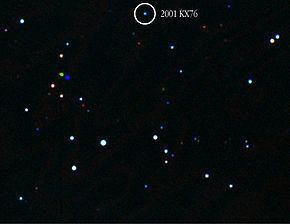Discovery date 22 May 2001 Pronunciation /ɪkˈsaɪ.ən/ ik-SY-ən Inclination 19.619° Orbits Sun | Alternative names 2001 KX76 Discovered 22 May 2001 Argument of perihelion 299.73° | |
 | ||
Discovered by Deep Ecliptic SurveyCerro Tololo (807) Similar 90482 Orcus, 20000 Varuna, 50000 Quaoar, Sun, Solar System | ||
28978 Ixion is a plutino (an object that has a 2:3 orbital resonance with Neptune). It is very likely to be a dwarf planet, although the IAU has not officially classified it as such. Light-curve-amplitude analysis shows only small deviations, which suggests that Ixion is a spheroid with small albedo spots and hence a dwarf planet. It has a diameter of approximately 7005650000000000000♠650 km, making it about the fifth-largest plutino. It is moderately red in visible light and has a surface made of a mixture of tholin and water ice.
Contents
It was discovered on May 22, 2001 by the Cerro Tololo Inter-American Observatory (807). It is named after Ixion, a figure from Greek mythology.
Physical characteristics
Other than Pluto, Ixion was the first trans-Neptunian object (TNO) discovered that was originally estimated to be larger than dwarf planet Ceres, Even in 2002, a year after its discovery, Ixion was still believed to be more than 1000 km in diameter, though the 2002 estimate was a result of a spurious detection at 250 GHz that was not confirmed by later observations. More recent estimates suggest that Ixion has a high albedo and is smaller than Ceres. Observations of Ixion by Herschel Space Telescope and Spitzer Space Telescope in the far-infrared part of the spectrum revealed that its size is about 620 km.
Ixion is moderately red (slightly redder than 50000 Quaoar) in the visible light. It also has a higher albedo (>0.15) than the mid-sized red cubewanos. There may be an absorption feature at the wavelength of 0.8 μm in its spectrum, which is commonly attributed to the alteration of surface materials by water. In the near-infrared the spectrum of Ixion is flat and featureless. Water ice absorption bands at 1.5 and 2 μm are absent. This is in contrast to Varuna, which has a red spectral slope in the near-infrared as well as prominent water absorption bands. Both visible and infrared spectroscopic results indicate that Ixion's surface is a mixture of water ice, dark carbon and tholin, which is a heteropolymer formed by irradiation of clathrates of water and organic compounds. The Very Large Telescope (VLT) has checked Ixion for cometary activity, but did not detect a coma. Ixion is currently about 41 AU from the Sun, and it is possible that Ixion could develop a coma or temporary atmosphere when it is closer to perihelion.
Orbit and rotation
Ixion and Pluto follow similar but differently oriented orbits: Ixion’s perihelion is below the ecliptic whereas Pluto's is above it. Uncharacteristically for bodies locked in resonance with Neptune (such as Orcus), Ixion approaches Pluto with less than 20 degrees of angular separation. Ixion is currently below the ecliptic and will reach its perihelion in 2070. Pluto has passed its perihelion (1989) and is descending toward the ecliptic. Ixion's orbital period is almost 250 Earth years, about 0.5% larger than Pluto's. Ixion does demonstrate some regular changes in brightness, which are thought to be caused by its rotation. As of 2010, however, the rotation period of Ixion remains undetermined.
